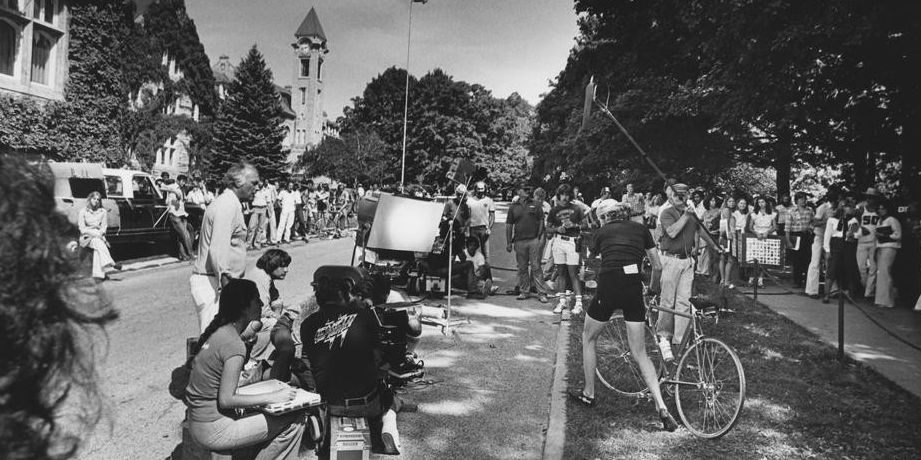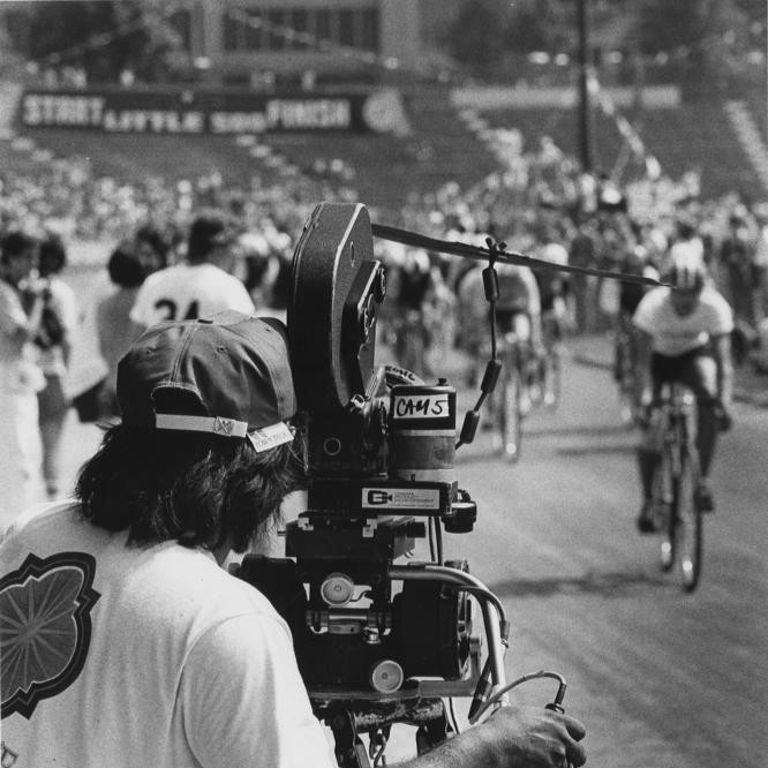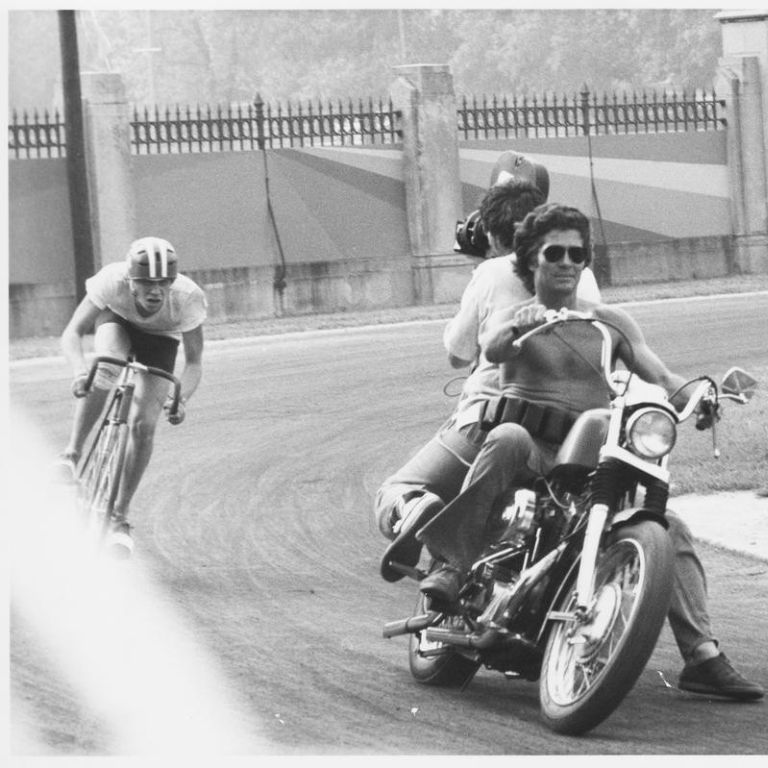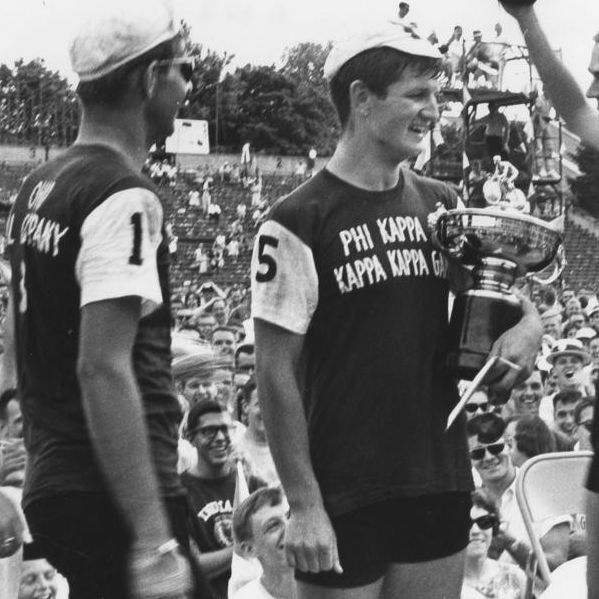Forty Little 500s ago in April 1979, Indiana University students, Bloomington locals, university administrators and Hollywood stars gathered at the IU Auditorium after the 29th running of the iconic race. A red carpet was rolled out – along with 15 yards of black-and-white checkered carpet borrowed from the Indianapolis Motor Speedway – to greet guests.
A movie theater marquee was hanging above the auditorium entrance. The world premiere of “Breaking Away” was about to begin.
Description of the following video:
[MUSIC]
[Video: A photo of the movie poster promoting the film Breaking Away appears and zooms out.]
[Words appear: It has been 40 years since the release of “Breaking Away.”]
[Video: A photo of a cameraman operating a camera on the Little 500 track during the filming of Breaking Away. Zooms in on photo.]
[Words appear: The film immortalizes IU’s Little 500 bike race …]
[Video: A photo of Steve Tesich appears and zooms in.]
[Words appear: … and was written by IU alumnus Steve Tesich.]
[Video: A photo appears of two cyclists standing atop a platform holding a trophy. Zooms in on photo.]
[Words appear: Tesich based the movie’s main character on his fraternity brother Dave Blase …]
[Video: A photo of a male cyclist pedaling around the track at Bill Armstrong Stadium. Zooms out.]
[Words appear: … who rode 139 of the race’s 200 laps to win the 1962 Little 500.]
[Video: A photo of the film crew shooting a scene for Breaking Away on the Bloomington campus near where the Sample Gates are today. Zooms in.]
[Words appear: The movie was shot in Bloomington during the summer and fall of 1978.]
[Video: A photo of four male cyclists from the Cutters team stand off to the side of the track. Spectators are in the background. Zooms in.
[Words appear: Producers staged a replica Little 500 in September 1978 …]
[Video: A photo of several male cyclists smiling and riding on the Little 500 track together. Zooms out.]
[Video: A photo of a man driving a motorcycle with a cameraman facing backwards on the back of the bike capturing video of a male cyclist riding around the Little 500 track. Zooms in.]
[Words appear: … and enlisted the help of IU students and administrators.]
[Video: A photo of Steve Tesich holding an Emmy Award. Zooms in.]
[Words appear: The film won the 1979 Academy Award for Best Original Screenplay.]
[Video: The Indiana University trident appears]
[Words appear: Indiana University]
[Words appear: Fulfilling the Promise]
[Words appear: indiana.edu]
The film follows four young working-class locals living in Bloomington, feuding with condescending IU students, chasing sorority girls and, for the film’s protagonist, obsessively riding bikes. The four convince then-IU President John Ryan, who has a small cameo in the film, to allow them to compete in the annual Little 500 bicycle race. Calling themselves Cutters, a derogatory term used for locals who cut limestone in the quarries, the team – spoiler alert! – triumphantly wins the race.
The screenplay was written by IU alumnus Steve Tesich, who based main character Dave Stoller on his IU fraternity brother and Little 500 teammate, Dave Blase. In the 1962 race, Blase rode 139 of 200 laps to win for the Phi Kappa Psi team. Stoller’s obsession with all things Italian was also inspired by Blase, who had spent a semester working with two Italian doctors at the campus medical center.
With a $2.4 million budget, the film was shot on campus and in Bloomington during the summer and fall of 1978. Scenes were shot in still recognizable spaces, like the commons at the Indiana Memorial Union, the square in downtown Bloomington and the Rose Well House in the campus’s Old Crescent. But Sanders Quarry, where the guys go swimming in one of the film’s first scenes, has since been filled in for safety concerns, and the Little 500 stadium moved north and replaced by the IU Arboretum.
The production of the film relied heavily on student extras and cooperation from administrators. According to coverage in the Indiana Daily Student that summer, extras were paid an hourly rate of $2.65. This did not include extras used in the final race scene, who were instead compensated with prizes like NCAA basketball tournament tickets.



Photos courtesy of IU Archives
To pull off a fake Little 500 in September, producers from 20th Century Fox enlisted the help of members of the IU Student Foundation who plan the real one. Riders who participated in the 1977 race were paid to ride on camera, and IU administrators – including then-Chancellor Herman B Wells and then-IU Foundation President Bill Armstrong – showed up to the shoot to provide the proper pomp and circumstance. For a bird’s-eye view of the track, camera crews positioned themselves atop Wells Library. The race scene took four days to shoot.
While IU students were an integral part of the film production, many were not completely pleased with the finished product. In a review of the movie published in the Indiana Daily Student on April 23, 1979, Eve B. Rose argues that the film misses the mark on an accurate portrayal of Bloomington life.
“The movie suggests that college kids and townspeople are constantly at each other’s throats,” she writes. “It is as if there are two huge youth gangs.”
Amy Harris, who was a 19-year-old student at the time of the premiere, told the Herald-Times, “It was a good movie, but I’m not sure that people outside of Bloomington and IU will like it as much as people here.”



Photos courtesy of IU Archives
Luckily for 20th Century Fox, Harris was wrong. The film opened to rave reviews from publications like The New York Times, and Rex Reed for Vogue magazine wrote that the final race scene “is as exciting as any Olympic footage I’ve ever seen.” It won the 1980 Academy Award and the Writers Guild of America Award, both for best original screenplay, and the New York Film Critics Circle Award for best screenplay.
In an attempt to capitalize on the film’s success, Tesich created a television spin-off for ABC. The show, which replaced Dennis Christopher with Shaun Cassidy in the role of Dave and employed an IU student as his stunt double, was shot in Athens, Georgia, instead of Bloomington because of the climate. It was canceled after eight episodes.
The failure of the show did not tarnish the film’s success, though. In addition to spurring $1.5 million in economic impact during shooting, hosting a premiere event that raised money for scholarships and inspiring a 20th Century Fox donation of $15,000 to the IU Foundation, “Breaking Away” is still widely recognized 40 years later as an homage to Bloomington, Indiana University and the “World’s Greatest College Weekend.”
Those interested in learning more about the history of the filming of “Breaking Away” can view newspaper articles, brochures, press releases and more at IU Archives.

